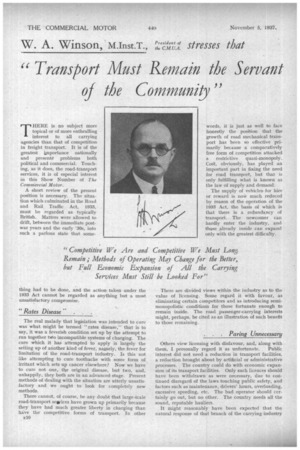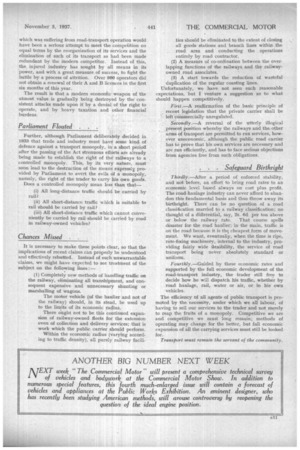"Rates Disease .
Page 18

Page 19

If you've noticed an error in this article please click here to report it so we can fix it.
The real malady that legislation was intended to cure was what might be termed "rates disease," that is to say, it was a feverish condition set up by the attempt to run together two incompatible systems of charging. The cure which it has attempted to apply is largely the setting up of another kind of fever, namely, the fever for limitation of the road-transport industry. Is this not like attempting to cure toothache with some form of irritant which sets up cancer elsewhere? Now we have to cure not one, the original disease, but two, and, unhappily, they both are in an advanced stage. Present methods of dealing with the situation are utterly unsatisfactory and we ought to look for completely new methods.
There cannot, of course, be any doubt that large-Scale road-transport sewices have grown up primarily because they have had much greater liberty in charging than have the competitive forms of transport. In other E10
There are divided views within the industry as to the value of licensing. Some regard it with favour, as eliminating certain competitors and as introducing semimonopolistic conditions for those fortunate enough to remain inside. The road passenger-carrying interests might, perhaps, be cited as an illus-tration of such benefit to those remaining.
. . Paring Unnecessary
Others view licensing with disfavour, and, along with them, I personally regard it as unfortunate. Public interest did not need a reduction in transport facilities, a reduction brought about by artificial or administrative processes. The country could do with economic expansion of its transport facilities. Only such licences should have been withdrawn as were necessary, due to continued disregard of the laws.-touching public safety, and factors such as maintenance, drivers' hours, overloading, excessive speeding,. etc. The bad operator should certainly go out, but no other. The country needs all the sound, reputable hauliers.
It might reasonably have been expected that the natural response of that branch of the carrying-industry which was suffering from road-transport operation would have been a serious attempt to meet the competition on equal terms by the reorganization of its services and the elimination of such of its transport as had been made redundant by the Modern competitor. Instead of this, the injured industry has sought by all means in its power, and with a great measure of success, to fight the battle by a process of attrition. Over 800 operators did not obtain a renewal of their A and B licences in the fust six months of this year.
The result is that a modern economic weapon of the utmost value is gradually being destroyed by the consistent attacks made upon it by a denial of the right to operate, and by heavy taxation and other financial burdens.
Parliament Flouted .
Further, although Parliament deliberately decided in 1933 that trade and industry must have some kind of defence against a transport monopoly, in a short period after the passing of the Act strenuous efforts are already being made to establish the right of therailways to a controlled monopoly. This, by its very nature, must soon lead to the destruction of the means expressly provided by Parliament to avert the evils of a monopoly, namely, the right of the trader to carry his own goods.
Does a controlled monopoly mean less than that (i) All long-distance traffic should be carried by rail?
(ii) All short-distance traffic which is suitable to rail should be carried by rail?
(iii) All short-distance traffic which cannot conveniently be carried by rail should be carried by road in railway-owned vehicles?
Chances Missed .
It is necessary to make these points clear, so that the implications of recent claims can properly be understood and effectively rebutted. Instead of such unwarrantable claims, we might have expected to see treatment of the subject on the following lines:— (1) Completely new methods of handling traffic on the railway, eliminating all transhipment, and consequent expensive and unnecessary shunting or marshalling of wagons.
The motor vehicle (of the haulier and not of the railway) should, in its stead, be used up to the limits of its economic radius.
There Ought not to be this continued expansion of railway-owned fleets for the extension even of collection and delivery services; that is work which the public carrier ,should perform.
Within the economic radius (varying according to traffic density), all purely railway facili ties should be eliminated to the extent of closing all goods stations and branch lines within the road area and conducting the operations entirely by road contractor.
(2) A measure of co-ordination between the overlapping functions of the railways and the railwayowned road associates.
(3) A start towards the reduction of wasteful duplication of the regular coasting lines. Unfortunately,we have not seen such reasonable expectations, but I venture a suggestion as to what should happen competitively.
First.—A reaffirmation of the basic principle of recent legislation that the private carrier shall be left commercially unregulated.
Secondly.—A reversal of the utterly illogical present position whereby the railways and the other arms of transport are permitted to run services, however uneconomic, although the public road carrier has to prove that his own services are necessary and are run efficiently, and has to face serious objections from agencies free from such obligations.
. . . Safeguard Birthright Thirdly.—After a period of enforced stability, and not before, an effort to bring road rates to an economic level based always on cost plus profit. The toad-haulage industry can never afford to abandon this fundamental basis and thus throw away its birthright. There can be no question of a road classification married to a railway classification; no thought of a differential, say, 2s. 6d per ton above or below the railway rate. That course spells disaster for the road haulier; in the main, traffic is on the road because it is till cheapest form of movement. We want, eventually, when the time is ripe, rate-fixing machinery, internal to the industry, providing fairly wide flexibility, the service of road transport being never absolutely standard or uniform.
Fourthly.—Guided by these economic rates and supported by the full economic development of the road--transport industry, the trader still free to decide how he will dispatch his traffic, whether by road haulage, rail, water or air, or in his own vehicles.
The efficiency of all agents of public transport is pro moted by the, necessity, under which we all labour, of having to sell our services to the trader and not merely to reap the fruits of a monopoly. Competitive we are and competitive we must long remain; methods of operating may change for the better, but full economic expansion of all the carrying services must still be looked. for.
Transport must remain the servant of the community.


















































































